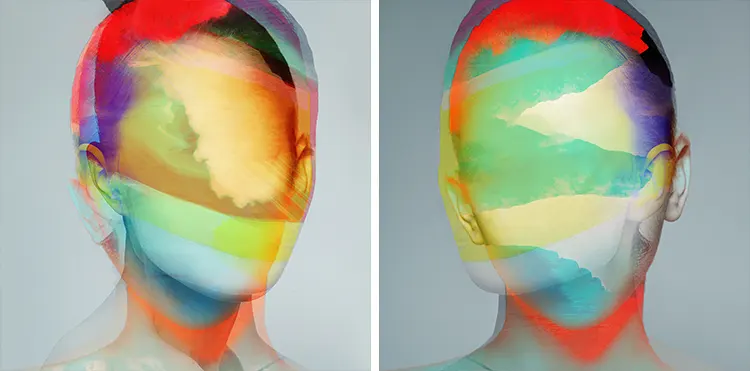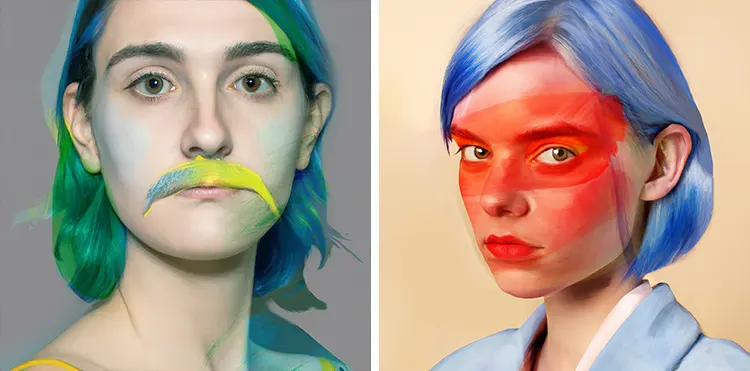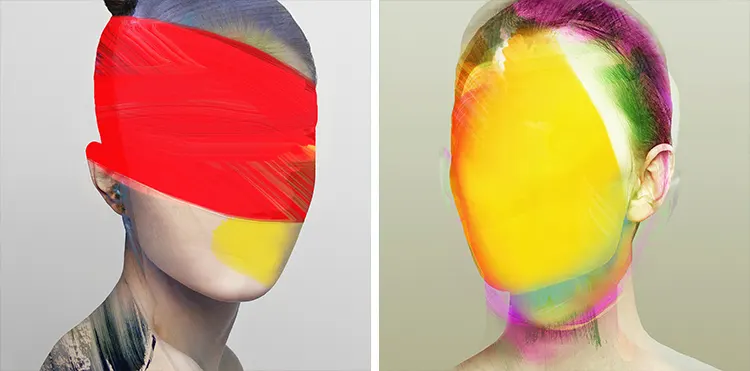“The digital journey is unstoppable, I think, but the human being will naturally evolve in the process.”
A Creative Journey Through Time
Born in the year 1969, the contemporary artist Nae Zerka now resides and carries out his creative endeavors in the historically rich city of Salzburg, Austria. Immersed in the continually evolving world of digital innovation, Zerka brings forth a unique approach to visual art, intertwining his fascination with technology with traditional painting techniques.
Being a child of the 80s, Zerka’s creative spirit was fueled by an engagement with computer-centric activities, encapsulating elements of electronic music and graphic design, both of which heavily inform his artistic practice today. His experience as a producer of electronic music and a DJ in renowned clubs sparked a fusion in his artistry, weaving elements from these spheres with a tactile, painterly approach. This integration, paired with the use of conventional artistic mediums such as oil and pastel, culminates in an art form that is both novel and transformative.
The journey of Zerka’s artistic evolution has been as diverse as his art. A wellspring of creativity in his formative years propelled him onto a path less traveled. The artist embarked on his journey intending to carve a niche in the realm of fashion design. However, the intriguing world of filmmaking lured him away, further directing him towards the domain of graphic design. His voyage across these creative terrains has been pivotal in shaping Zerka’s unique artistic voice and the dynamic fusion that characterizes his work today.

The Seminal Themes: Transformation and Manipulation
The 90s served as Nae Zerka’s gateway into the mesmerizing realm of techno music, shaping him into a prodigious DJ and music producer. This transformative period cultivated in him a deep-seated appreciation for visual artists, sparking a latent curiosity in painting and the broader sphere of art. Soon after, Zerka embarked on an innovative journey, amalgamating painting with the contemporary medium of computers and graphic design. The evolution of his artistic practice was not immediately unveiled, however; he deferred publicizing his work, with the eventual reveal marking the dawn of his illustrious career in art.
The artistic ethos of Nae Zerka orbits around the seminal themes of Transformation and Manipulation. Viewed through the lens of his creative vision, transformation is a foundational shift steered by the potential of technology and societal requirements. Our generation finds itself at the pivotal intersection of pervasive digitization and the flux of human needs. Zerka, being a vanguard artist immersed in the digital sphere, embodies these transformative fluctuations in his work.
With black and white portraiture as his canvas, Zerka ventures into the creation of 3D meshes, introducing painterly embellishments as a final touch. The culmination of his work, a compelling fusion of photography and painting, redefines traditional methodologies through the lens of innovation. Thus, in Zerka’s hands, boundaries are blurred and conventions are reimagined, reflecting the intricate dance of transformation that underpins his art.

The Artistic Process and Inspirations
Nae Zerka’s creative journey customarily commences within the digital realm of his computer, the conception site of his ideas and preliminary sketches. Devoting approximately a month to refining each creation, Zerka seamlessly transitions into a repertoire of traditional artistic techniques. This phase incorporates mediums such as print, oil colors, pastels, and colored pencils, evidencing a fluid marriage of digital and conventional practices.
Although the prospect of distractions might occasionally lead to frustration, Zerka views these interruptions with a nuanced perspective. He regards them as opportunities for temporal detachment, valuable moments that often pave the way to a refreshing influx of new ideas.
Among the figures who have profoundly influenced Zerka’s artistic journey, the pioneering Robert Rauschenberg stands out. The groundbreaking nature of Rauschenberg’s oeuvre, characterized by his use of unconventional materials and techniques, found a strong resonance within Zerka. Particularly impactful were Rauschenberg’s explorations of image transfer and printmaking techniques in the late 1950s, which in many ways prefigured Zerka’s own work processes. Thomas Ruff, too, features prominently in the constellation of Zerka’s inspirations, with Ruff’s deft manipulations of pre-existing image materials serving as a rich source of motivation.
A particularly notable example of Zerka’s oeuvre is the piece entitled “The Initiation”. This artwork encapsulates the concept of transformation, with an emphasis on humanity’s inexorable march towards digitization. However, “The Initiation” also illuminates a form of erasure, a disruptive transformation that signifies the quiet, gradual loss of individual identity in the face of emerging possibilities. Despite this, Zerka holds an unwavering belief in the resilience of human evolution. He posits that, even in the age of pervasive progression, humanity will continue to adapt, evolve and thrive.

Ambitious Dreams: Redefining Artistic Boundaries
The artistic journey of Nae Zerka has been characterized by a comprehensive exploration of varied materials and mediums. This process of trial and error, which has often led to a series of spectacular failures, has provided Zerka with critical insights that have honed his creative focus. His trajectory has taken him towards an amalgamation of digital elaboration and traditional painting, wherein the artist has found a profound connection. This fusion has emerged as a distinctive signature in Zerka’s portfolio, presenting a compelling blend of the past and the future, the traditional and the innovative.
In the course of his artistic exploration, Zerka has harbored a dream of grandeur that could be the epitome of his creative journey. He envisages an expansive canvas stretching across an entire wall of the Museum der Moderne in Salzburg. This project, which is yet to materialize, would not simply be a grand showcase of Zerka’s work, but also a transformative reinterpretation of the conventional confines of portrait photography and painting.
For this venture, Zerka is planning to exhibit 32, 64, or even 128 pieces from his new series, each of them a testament to his innovative approach and unique artistic vision. This undertaking, he hopes, will allow him to manipulate and reimagine the tradition of portraiture. In essence, the project symbolizes the culmination of Zerka’s artistic evolution, as he seeks to transform established norms and carve out new expressive territories.
Through his continuous exploration and determination, Zerka aims to redefine the boundaries of artistic expression. The convergence of his past experiences and current aspirations will, he believes, ultimately bring this ambitious project to fruition. Thus, Nae Zerka, through his persistent endeavor and innovative vision, continues to push the envelope of what is conventionally understood as the fusion of digital elaboration and traditional painting.






